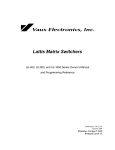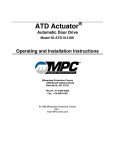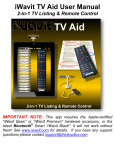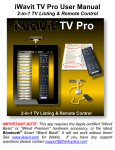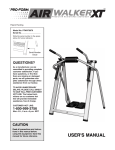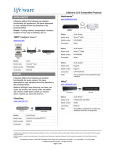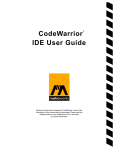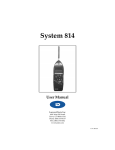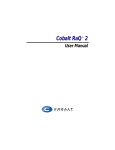Download Vaux Electronics Lattis 800 Series Owner`s manual
Transcript
Lattis Matrix Switcher 1600 and 800 Series Owner’s Manual Publication M-LE-00 Manual Revision Jan. 1999 Software Version 4.00 Model Number:_______________ Serial Number:_______________ Date Purchased:_______________ Place of Purchase:_______________ For more information, visit our web site: www.vauxelectronics.com or email us: [email protected] Vaux Electronics, Inc. Arizona, USA PHONE: (480) 354-5556 FAX: (480) 354-5558 ©1999 Vaux Electronics, Inc. Printed in the U.S.A. All rights reserved. Aris, Lattis, MediaMation, Vaux, VauxConfig, VauxControl, VauxNet, and VauxProtocol are trademarks of Vaux Electronics, Inc. Other trademarks and registered trademarks are owned by their respective companies. 2 INTRODUCTION.............................................................................................................. 4 Matrix Switching and Zone Expansion.......................................................................................................................4 IR Remote Control and Keypad Operation................................................................................................................4 Computer Control Systems.......................................................................................................................................... 4 LATTIS MATRIX SWITCHER FRONT PANEL................................................................ 5 LATTIS MATRIX SWITCHER (LE-1600A) REAR PANEL.............................................. 5 PARTS CHECKLIST........................................................................................................ 6 INSTALLATION............................................................................................................... 6 RC-8-IR REMOTE CONTROL......................................................................................... 7 VAUXPROTOCOL COMMANDS & MESSAGES (RS-232)............................................ 8 Control-Command & Status-Message Summary:..................................................................................................... 9 Request-Command & Status-Message Summary:................................................................................................... 10 Configuration-Commands & Configuration-Message Summary:......................................................................... 10 Command/Message Parameter Notes:...................................................................................................................... 11 VC-232 SERIAL PORT (EIA/RS-232)........................................................................... 13 VC-232 Port (RS-232 Interface) (DB-9 F Connector):...........................................................................................13 MAINTENANCE AND SERVICE.................................................................................... 14 LIMITED WARRANTY................................................................................................... 15 SAFETY INFORMATION............................................................................................... 16 3 Introduction Thank you for selecting a Vaux Lattis Matrix Switcher. These systems have been designed for the utmost in performance and reliability. There are currently three models in the Lattis Matrix Switcher family: LE-800A LE-800AV LE-1600A 8-source by 8-zone, audio-only 8-source by 8-zone, audio/video 16-source by 16-zone, audio-only Each of the systems provides high-fidelity stereo line-level switching, zoned volume/bass/treble/muting, programmable min/max/mute/initial-volumes, and other customizable features. The systems may be controlled using infrared remote controls, keypads, and/or RS-232 serial control from a computer or other control system (e.g. AMX, Crestron…). The source inputs are driven from any line-level source, while the volume-controlled zone outputs connect to power amplifiers for each stereo zone. In the case of the LE-800AV, the video switching is line-level composite video, for NTSC or PAL systems. Matrix Switching and Zone Expansion The Lattis Matrix Switcher is a multi-source/multi-zone audio (or audio/video) distribution and control system. A Lattis system allows multiple audio (or audio/video) sources to be routed to multiple zones (one or more rooms). Each zone of the system has independent control over source-selection, volume/bass/treble levels, muting, etc. Multiple Lattis Matrix Switchers may be combined to expand the number of zones. For example, three 16x16 Lattis LE-1600A switchers may be use to provide a 16-source by 48-zone system. The units are simply programmed to respond to different “Base-Zones,” (1, 17, and 33) allowing contiguous zone numbers from 1 to 48. A Vaux system may expand this way to a total of 255 zones. The audio sources may simply use “Y-cables” to split to two or three Lattis inputs, or a “Distribution-Amp” (DA) may be used to buffer each source for driving multiple Lattis Matrix Switchers. For video sources (e.g. using a Lattis LE-800AV), a DA is mandatory to maintain proper 75-ohm video line impedance. You may also mix and match Lattis switchers to provide different features. For example, an 8x8 audio-only LE800A may be combined with an 8x8 audio/video LE-800AV, providing eight sources by sixteen zones (eight of these zones have video). IR Remote Control and Keypad Operation Lattis Matrix Switchers may be operated by hand-held Vaux RC-8 infrared (IR) remote controls. The remote controls allow selection of A/V source, adjustment of each zone’s Volume/Bass/Treble levels, as well as some system setup functions. The Vaux RC-8 remote control is easily programmed to control one specific numbered zone – the remote’s zone number may easily be changed to move the remote to a different room. IR control from multiple rooms will require a wired or wireless IR-Repeater system, which uses IR sensors in each room. The Vaux RC-8 remote may also be used to teach the Vaux control codes (for one zone) to a third-party hand-held “learning” remote. Vaux programmable keypad systems may also be used to control Lattis systems. Additionally, third-party IRlearning keypads may also be employed, using a Vaux RC-8 remote to teach the Lattis commands to the keypad. Computer Control Systems The Lattis Matrix Switcher may be completely controlled by an attached computer, or other control system (such as AMX or Crestron) which communicates over a serial, RS-232 connection. The host computer has complete control over A/V zone switching, volume/bass/treble levels for each zone, etc. The Lattis system sends messsages to the control system confirming actions for not only RS-232 commands, but also for IR- or keypad-generated commands, closing the loop on the whole system. The control system may optionally poll periodically for system status, or may simply ignore messages for a basic command-only interface. Serial communication uses the VauxProtocol standard, presented later in this manual. 4 Lattis Matrix Switcher Front Panel Power Switch Infrared Contol Sensor (below switch, left of logo) Power light Active light (one or more zones on) Ack light (acknowledge) Nak light (negative acknowledge) Prog light (programming) Lattis Matrix Switcher (LE-1600A) Rear Panel Audio/Video Source Inputs (phono jacks) Ñ 8 or 16 input sources for line-level stereo audio; Audio/Video Zone Outputs (phono jacks) Ñ 8 or 16 output sources for line-level stereo audio; The audio outputs are volume/bass/treble/mute controlled within the Lattis Matrix Switcher and connect to zone power amplifiers (sized appropriately for each zone). VC-Exp connector (6P6C) Expansion port for 232 daisy-chaining and keypad hub connection. Memory-Erase button. Careful Ñ will restore all factory settings, etc. VIO-1 connector (Mini-DIN-6) Future use. VC-232 connector (9-pin DB-9-F) RS-232 serial control port.. Power connector (2.1mm connector, auto-polarity) For 12 VDC, 800mA adapter. 5 Parts Checklist When unpacking your Lattis system, ensure that you have received the following: • Lattis Matrix Switcher (LE-800A, LE-800AV, LE-1600A) • 12 VDC, 800 mA AC Adapter • Owner’s Manual Other components you may need: • Vaux RC-8-IR infrared remote control(s) • Infrared repeater system • Keypad control system • Source components, zone power amplifiers, speakers • Audio/Video connecting cables • RS-232 connecting cable • • Installation The Lattis Matrix Switcher is quite flexible, in that it can integrate with a variety of A/V devices and control systems, and may be configured a variety of ways. Installation of the Lattis Matrix Switcher is described below: 1. Switcher Power: Place the Lattis Matrix Switcher near your audio/video components. Turn off the Lattis front panel switch and plug the AC power adapterÕs cable into the rear panel Power connector on the Lattis Matrix Switcher. Plug the adapter into a standard electrical outlet Ñ select an outlet which is not controlled by a wall switch. 2. Optional Connection of Vaux Wired Keypads: If you are installing Vaux wired keypads, plug the Vaux Data cable from the keypad connecting hub into the VC-Exp connector. 3. Optional IR Input from Repeater Systems or Keypads: Affix an IR emitter on the front-panel sensor. 4. Optional RS-232 Computer or Control System Connection: Connect your computer or control system, using a properly wired RS-232 cable, to the 9-pin VC-232 connector on the rear panel of the Lattis Matrix Switcher. For more information on the VC-232 interface, refer to a later manual section. 5. Connection of A/V Source components: Plug your Audio/Video source components into the Lattis Source inputs using appropriate cabling. 6. Connection of A/V Zone amplifiers: Connect the Lattis Zone audio outputs to power amplifiers appropriate for each zone. For video-capable switchers, connect the video outputs to video monitors, or, for longer runs, to composite buffer amplifiers or video modulators. Run the speaker wiring and video cables to each zone. NOTE: Do not use level-sensing amp-powering options Ñ low volumes may turn the amp off. 7. Power-up the system: Turn on the Lattis Matrix Switcher using the front-panel switch Ñ a string of front-panel lights indicates that the Switcher is running. 8. Install batteries in the RC-8 remote control(s). Three (3) ÒAAAÓ batteries: alkaline, Heavy-Duty Carbon, or rechargeable Nicad batteries may be used. Please dispose of used batteries at a recycling center. These batteries will last up to 1 year under normal conditions, depending on usage. Be certain to observe polarity markings when installing batteries. 6 RC-8-IR Remote Control The Vaux RC-8-IR Remote Control may be used to operate the Lattis Matrix Switcher. When the batteries are first installed, the remote control will use Òfactory settingsÓ for the programmable features it stores. Upon battery insertion, the red light flashes twice to indicate that the factory settings have been loaded. The user may at any time change these settings. The factory settings are: • Current A/V Device: 01 ( Tuner ) • Default A/V Zone: 01 Batteries should be changed when the low-battery indication is given, that is the red and green lights flashing simultaneously when a button is pressed. Although you may continue to operate the remote control, operating range will be reduced and remaining battery life is short. The Remote uses three (3) ÒAAAÓ batteries; alkaline preferred. The remote control has a three-position slide switch which selects the operating mode; Audio/Video, Lights/App, or MACROs. The Audio/Video mode is used to operate the Lattis Matrix Switcher, to select A/V sources, adjust zone volume/bass/treble/mute, etc. The Lights/App and the MACRO positions are not used with the Lattis Matrix Switcher There are several special buttons on the remote control; the SHIFT button, eight Device buttons (Tuner, CD, etc.), the Zone button, the Sec button, and the Learn button. These are used for multi-button commands or system programming tasks. The Zone button allows you to change the ÒdefaultÓ zone stored in the RC-8 Remote Control, allowing you to access different zones. This default zone is used to uniquely identify different remotes, since the zone information is included in the transmitted commands. For example, if you will be leaving the RC-8 in the room(s) for zone 03, you would set the default zone to 03. Then, when you press buttons on the RC-8, it tells the Lattis Matrix Switcher that you are Òin zone 03.Ó To change the remote’s Default-Zone: Press and release the Learn key, then press and hold the Zone key, until the green led lights; now press two digits corresponding to the desired zone (eg: 02, or 15). To select a source, press one of the source selection keys (only the first eight sources are available when using the RC-8 remote). To turn off the zone, press the Off key. The On key selects the previous source. Source 1 2 3 4 RC-8 Label Tuner CD Cab/Sat VCR-1 Source 5 6 7 8 RC-8 Label VCR-2 Laser Tape-1 Tape-2 Volume is adjusted using the Volume-Up/Dn keys, and the Mute key toggles the zone’s audio mute. To adjust bass, first press the Shift key, and then press the Channel-Up/Dn keys, also labeled Bass. Treble if adjusted similarly using shifted volume keys. Bass and treble adjustment may only be performed in single up or down steps (you cannot press and hold, as with the volume adjustment). Finally, you may set the zone’s Initial-Volume (the level the zone turns on at, by first adjusting the volume to the desired level, and then pressing Shift-Limit (the shifted FFD key). 7 VauxProtocol Commands & Messages (RS-232) Connection of a computer or control system to the VC-232 serial port allows you to fully control the system using a selection of Commands, and to obtain immediate feedback on system status by listening to Messages. This Command/Message language is called VauxProtocol. VauxProtocol Commands begin with an asterisk (*), followed by two letters, then one or more comma-delimited decimal number parameters, and finally a carriage-return and/or line-feed char (CR/LF). The numbers are asciiencoded-decimal number strings which may range from 0 to 255. The decimal numbers may be one, two, or three digits total, and may include leading zeroes, or not, as desired (ie: 001, 01, and 1, are all equivalent). A comma must be used to delimit fields, and the command requires a CR, LF, or CR/LF as termination delimiter -indicated by <cr>. Spaces may be removed, or inserted if desired (they are ignored). Note: the following commands are all identical: *PW,001,017 <cr> or: * P W, 001 , 017 <cr> (extra spaces are ignored) or: *PW,1,17 <cr> (leading zeros also optional) Similarly, VauxProtocol Messages begin with an exclamation (!), followed by two letters, and then one or more comma-delimited decimal number parameters, and a terminating CR/LF. 8 Control-Command & Status-Message Summary: • • • • For zones 1 to 255, Status-Messages are sent in response to Control-Commands. Many commands return the same status message – simplifying message parsing programming. For zone 0 (all zones), no messages returned (multiple controllers would be responding together). Note that volume/bass/treble/mute commands will only affect zones that are not off, even if the requested zone is 0. • A muted zone will be unmuted if 1) a new route command is received, or 2) a stereo volume command (*CW,20/23/24/25/35/36) is received. Coding Tip: You will likely only need to implement a handful of commands/messages in a typical application! Coding Tip: Status messages are also sent in response to remote-control or keypad control – by parsing the messages independently of the command programming, and updating internal variables in your program, you will close the loop on the whole system. You may then send commands blindly, and allow you message-handler to update your variables/displays. If you wish to ensure that your command resulted in an action, you may monitor internal variables after sending your command (instead of waiting for the actual message), and implement timeout/retry/alert code as desired for your application. This is a more generalized technique than simply sending a command and then waiting to parse an ack mssg. Control-Cmd Description Command Status-Message Route Audio/Video ssa/ssv (ZONE-0 OK) Route Audio Source ssa (ZONE-0 OK) Route Video Source ssv (ZONE-0 OK) Route Audio/Video src (ZONE-0 OK) *CW,10,zon,ssa,ssv <cr> *CW,11,zon,ssa <cr> *CW,12,zon,ssv <cr> *CW,13,zon,src <cr> !S,10,zon,ssa,ssv <cr> !S,11,zon,ssa <cr> !S,12,zon,ssv <cr> !S,10,zon,ssa,ssv <cr> Set L & R Volumes vvl/vvr (ZONE-0 OK) Set Left Volume vvl Set Right Volume vvr Set Volume (-64 to 0 dB) (ZONE-0 OK) Volume-Up (2-dB/step) (ZONE-0 OK) Volume-Dn (2-dB/step) (ZONE-0 OK) Left Volume-Up (2-dB/step) Left Volume-Dn (2-dB/step) Right Volume-Up (2-dB/step) Right Volume-Dn (2-dB/step) Balance to Left (L-up/R-dn) Balance to Right (R-up/L-dn) *CW,20,zon,vvl,vvr <cr> *CW,21,zon,vvl <cr> *CW,22,zon,vvr <cr> *CW,23,zon,vol <cr> *CW,24,zon <cr> *CW,25,zon <cr> *CW,26,zon <cr> *CW,27,zon <cr> *CW,28,zon <cr> *CW,29,zon <cr> *CW,30,zon <cr> *CW,31,zon <cr> !S,20,zon,vvl,vvr <cr> !S,21,zon,vvl <cr> !S,22,zon,vvr <cr> !S,20,zon,vvl,vvr <cr> !S,20,zon,vvl,vvr <cr> !S,20,zon,vvl,vvr <cr> !S,21,zon,vvl <cr> !S,21,zon,vvl <cr> !S,22,zon,vvr <cr> !S,22,zon,vvr <cr> !S,20,zon,vvl,vvr <cr> !S,20,zon,vvl,vvr <cr> Start Ramping Volume Up *CW,35,zon <cr> !S,20,zon,vvl,vvr <cr> (per step) Start Ramping Volume Down *CW,36,zon <cr> !S,20,zon,vvl,vvr <cr> (per step) Stop Ramping Volume *CW,37,zon <cr> (none) NOTE: volume ramps at 2-dB/120-msec until stopped, or Max-Vol reached! Set Bass/Treble levels bas/trb Flat Bass/Treble (0-dB) (ZONE-0 OK) Bass-Up, relative (3-dB/step) Bass-Down, relative (3-dB/step) Treble-Up, relative (3-dB/step) Treble-Down, relative (3-dB/step) *CW,40,zon,bas,trb <cr> *CW,41,zon <cr> *CW,42,zon <cr> *CW,43,zon <cr> *CW,44,zon <cr> *CW,45,zon <cr> !S,40,zon,bas,trb !S,40,zon,bas,trb !S,40,zon,bas,trb !S,40,zon,bas,trb !S,40,zon,bas,trb !S,40,zon,bas,trb Audio Mute Toggle Audio Mute On Audio Mute Off *CW,50,zon <cr> *CW,51,zon <cr> *CW,52,zon <cr> !S,50,zon,sta <cr> !S,50,zon,sta <cr> !S,50,zon,sta <cr> (ZONE-0 OK) (ZONE-0 OK) 9 <cr> <cr> <cr> <cr> <cr> <cr> Request-Command & Status-Message Summary: Status-Message are sent in response to above Control-Commands, but system status may also be determined at any time (by polling) using these optional Request-Commands (zon=0 not allowed). Coding Tip: You probably do not need to need to use these commands, in most applications! Request-Command Description Get Zone-Status Get Audio/Video ssa/ssv route source Get Audio Source ssa route source Get Video Source ssv route source Get Left/Right Volumes vvl/vvr Get Left Volume vvl Get Right Volume vvr Get Bass/Treble bas/trb Get Audio Mute state Command Status-Message *CR,1,zon <cr> !S,1,zon,sta,stv,ssa,ssv,vvl,vvr,bas,trb <cr> *CR,10,zon <cr> !S,10,zon,ssa,ssv <cr> *CR,11,zon <cr> !S,11,zon,ssa <cr> *CR,12,zon <cr> !S,12,zon,ssv <cr> *CR,20,zon <cr> !S,20,zon,vvl,vvr <cr> *CR,21,zon <cr> !S,21,zon,vvl <cr> *CR,22,zon <cr> !S,22,zon,vvr <cr> *CR,40,zon <cr> !S,40,zon,bas,trb <cr> *CR,50,zon <cr> !S,50,zon,sta <cr> Configuration-Commands & Configuration-Message Summary: Coding Tip: In many applications, the factory settings are just right – you may want to tweak Initial Volumes. Config-Write-Cmd Description Command Write controller's Base Zone Write Minimum-Volume-Level Write Maximum-Volume-Level Write Initial-Left-Vol-Level Write Initial-Right-Vol-Level Write Mute-Volume-Level Write Bass-Level Write Treble-Level Write Zone Mode Write Taper-Up-Delay Write Taper-Down-Delay Write Config-Table *PW,1,bzn <cr> 1 *PW,10,zon,vll <cr> 0 (-64 dB) *PW,11,zon,vhh <cr> 32 (0 dB) *PW,12,zon,vil <cr> 22 (-20 dB) *PW,13,zon,vir <cr> 22 (-20 dB) *PW,14,zon,vmm <cr> 0 (-64 dB) *PW,15,zon,bas <cr> 4 (0 dB) *PW,16,zon,trb <cr> 4 (0 dB) *PW,17,zon,mod <cr> 1 (stereo) *PW,18,zon,tud <cr> 20 (ms/2-dB-step) *PW,19,zon,tdd <cr> 5 (ms/2-dB-step) *PW,30,zon,vll,vhh,vil,vir,vmm,bas,trb,mod,tud,tdd <cr> Config-Read-Cmd Description Command Read Read Read Read Read Read Read Read Read Read Read Read *PR,1 <cr> !C,1,bzn <cr> *PR,10,zon <cr> !C,10,zon,vll <cr> *PR,11,zon <cr> !C,11,zon,vhh <cr> *PR,12,zon <cr> !C,12,zon,vil <cr> *PR,13,zon <cr> !C,13,zon,vir <cr> *PR,14,zon <cr> !C,14,zon,vmm <cr> *PR,15,zon <cr> !C,15,zon,bas <cr> *PR,16,zon <cr> !C,16,zon,trb <cr> *PR,17,zon <cr> !C,17,zon,mod <cr> *PR,18,zon <cr> !C,18,zon,tud <cr> *PR,19,zon <cr> !C,19,zon,tdd <cr> *PR,30,zon <cr> !C,30,zon,vll,vhh,vil,vir,vmm,bas,trb,mod,tud,tdd <cr> controller's Base Zone Minimum-Volume-Level Maximum-Volume-Level Initial-Left-Vol-Level Initial-Right-Vol-Level Mute-Volume-Level Bass-Level Treble-Level Zone Mode Taper-Up-Delay Taper-Down-Delay Config-Table 10 Factory setting Config-Message Command/Message Parameter Notes: zon is zone 0 to 255 (0=all) (or 1 to 255, depending on command) (no !S mssg returned for zon=0 cmds) src is audio/video source ssa is audio source ssv is video source 0 to 8 (0=off) 0 to 8 (0=off) 0 to 8 (0=off) vol is volume (left and right) vvl is left volume level vvr is right volume level 0 to 32 (2-dB/increment) 0 to 32 (2-dB/increment) 0 to 32 (2-dB/increment) 32 0 dB (max/passthrough volume level) 31 -2 dB 30 -4 dB ... 2 -60 dB 1 -62 dB 0 -64 dB (min volume level) bas is bass level trb is treble level 0 to 8 (3-dB/increment) 0 to 8 (3-dB/increment) 8 +12 dB (max bass/treble level) 7 +9 dB 6 +6 dB 5 +3 dB 4 0 dB (flat bass/treble level) 3 -3 dB 2 -6 dB 1 -9 dB 0 -12 dB (min bass/treble level) sta is audio-state code stv is video-state code 0=off, 1=on, 2=on/muted-audio 0=off, 1=on (or 0 to 16, depending on controller) (or 0 to 16, depending on controller) (or 0 to 16, depending on controller) NOTE: Independent Audio Left and Right Volume Commands: Source is always the same for L&R channels, but these commands allow you to provide independent volume for two mono rooms, if the zone is programmed for mono operation. If the zone is programmed for stereo operation, you may use these left and right commands to balance the zone, or you may use the balance commands. The left and right volumes may be different -- the volume up/down commands operate on both channels, relative to the volume of each. bzn is Base-Zone 1 to 248 for 8-zone controller (1 to 240 for 16-zone ctrl) (typical bzn: 1, 9, 17...) NOTE: Only connect to one controller when programming 11 mod is Zone Audio Mode 0=mono, 1=stereo, 3=spatial-stereo tud is Taper-Up-Delay tdd is Taper-Down-Delay 0 to 30 (ms/2-dB-step) 0 to 30 (ms/2-dB-step) vll is Minimum-Volume-Level vhh is Maximum-Volume-Level vmm is Mute-Volume-Level vil is Initial-Left-Volume-Level vir is Initial-Right-Volume-Level 0 to 32 0 to 32 0 to 32 0 to 32 0 to 32 (2-dB/increment) (2-dB/increment) (2-dB/increment) (2-dB/increment) (2-dB/increment) NOTE: Min-vol has priority over mute-vol and init-vol, and is the absolute min volume zone will reach. If min-vol incorrectly set above max-vol, then min-vol will be presumed to be zero. NOTE: Max-vol has priority over all other settings, and is the absolute max volume zone will reach. NOTE: Min-Vol and Max-Vol must be set before setting Initial-Volumes. If init-vol incorrectly set above max-vol, then init-vol will be presumed to be max-vol. If init-vol incorrectly set below min-vol, then init-vol will be presumed to be min-vol. NOTE: Min-Vol and Max-Vol must be set before setting Mute-Volume. Mute always acts upon both L&R channels, even though L&R volume levels may differ; balance is preserved when zone is unmuted. Mute-vol is a ceiling, not a hard level. If mute-vol set above min-vol, zone volume levels may go below mute-vol level. When muting, volumes above mute-vol will lower to mute-vol level, but volumes below mute-vol will not change. If mute-vol incorrectly set above max-vol, then mute-vol will be presumed to be max-vol. If mute-vol incorrectly set below min-vol, then mute-vol will be presumed to be min-vol. 12 VC-232 Serial Port (EIA/RS-232) The VC-232 Port is designed to connect directly to any computer or control system which has a standard RS-232 serial port. For the record, instead of RS-232 (RS stands for Recommended Standard), the proper term is actually EIA-232 or EIA/TIA-232 (for the standards bodies concerned). However, the EIA/TIA designation never really caught on, and virtually everyone retains the RS-232 terminology. A cable (not supplied) is needed to connect the VC-232 Port to the control system or computer serial port. The VC232 Port is a DB-9 F (female) connector – the connector pinout is defined below. Typically, only three wires are needed: TX, RX, and Ground. Depending on the setup of your control system serial port, you may need to connect other signals before the port becomes active. If your serial port expects handshake inputs (on CTS, DSR, and/or DCD), you may be able to either change your port configuration to ignore these signals, or you may provide the appropriate signals from the Vaux VC-232 connector. The Vaux end does not need special treatment Ñ the VC-232 handshake input pins (RTS and DTR) are not used. Vaux systems communicate at 9600 baud (bits-per-second) using 8 bits of data, no parity, and one stop bit. The serial port on the controlling computer must be configured according to its manufacturer’s instructions. Information transfer between the controlling computer and the Vaux system is in the VauxProtocol format Ñ a Vauxdefined command language comprised of various commands and messages. VC-232 Port (RS-232 Interface) (DB-9 F Connector): Pin 1 2 3 4 5 6 7 8 9 Description DCD (Data Carrier Detect) RXD (Receive Data) TXD (Transmit Data) DTR (Data Terminal Ready) Signal Ground DSR (Data Set Ready) RTS (Request To Send) CTS (Clear To Send) IRU (private Vaux signal) Signal Direction Computer <Ñ Vaux Computer <Ñ Vaux Computer Ñ> Vaux Computer Ñ> Vaux Ñ Computer <Ñ Vaux Computer Ñ> Vaux Computer <Ñ Vaux DO NOT CONNECT • • • • Vaux Use “Active” level output * Data Out Data In [not used] Signal Ground “Active” level output * [not used] “Active” level output * (special) ** Typical Connections: TXD, RXD, and Signal Ground. Minimal Connections: TXD, and Signal Ground (commands only) * One or more of CTS/DSR/DCD may need to be connected to your serial port, if expected. ** Pin 9 should not be connected to a computer serial port, as it is sometimes used for the Ring Indicator (RI) input – the Vaux IRU (unmod IR) signal should be left open for proper system operation. • Pins listed as not used, are not connected (to anything) in the Vaux system. • The DB-9 shield rim (the “D”) is connected to signal ground. 13 Maintenance and Service Vaux systems are designed to be maintenance-free, but do contain sensitive electronic parts. Avoid rough treatment to assure best performance. If you must ship the system, use the original packaging (or equivalent) for protection. The enclosures may be cleaned with a soft, slightly-damp soft cloth. Never use detergents, excess water, treated cloths, harsh cleaning agents, or sprays. This product is to be serviced only by the manufacturer or its authorized service agents. For instructions on how to obtain service, call the Vaux Electronics Service Department. Attach your sales receipt to this manual for future reference, should service be required during the warranty period. Also, record your Serial Number(s) on the cover of this manual. Serial Numbers can be found on rear-panel labels. For more information on product service, see the Limited Warranty section. 14 Limited Warranty What does your warranty cover? Any defect in material or workmanship. For how long after the original purchase? Three-year limited warranty on Lattis Matrix Switchers. One-year limited warranty on Vaux Remote Controls. What will we do? If your Vaux product is defective and returned within 30 days of the date it was purchased, we will replace it at no charge to you. If your Vaux product is returned after 30 days, but within the warranty repair period, we will repair it, or, at our option, replace it at no charge to you. If we repair your Vaux product , we may use new or reconditioned replacement parts. If we choose to replace your Vaux product, we may replace it with a new or reconditioned unit of the same or similar design. The repaired or replacement unit will be warranted for either (a) 90 days or (b) the remainder of the original warranty period, whichever is longer. How do you make a warranty claim? To get warranty service for your Vaux product, you must provide proof of purchase. The “Purchase Date” is the date shown on your invoice. Within 30 days of the Purchase Date, return your Vaux product to your place of purchase for immediate replacement. After 30 days of the date it was purchased, call the Vaux Service Department to obtain a Return Materials Authorization (RMA) Number and ship the Vaux product standard UPS or equivalent to the Vaux Electronics Service Dept. Provide necessary additional shipping insurance. Most shipping companies’ basic insurance coverage is only $100.00. Include in the package a copy of the sales receipt or other evidence of date of original purchase. Also print your name, shipping address (no PO boxes), phone number and a description of the defect. Write the RMA number on the shipping label or prominently on the outside of the box. Properly pack your unit, include any cables, etc., which were originally provided with the product. Please use the original carton and packing materials, or equivalent. Pay any charges billed to you by the Vaux Service Department for service not covered by the warranty. Your repaired unit will be shipped to you prepaid freight. What does your warranty not cover? This warranty does not cover any upgrades of system hardware or software to revisions later than that which shipped with the system when originally purchased. If this Vaux product includes infrared learning, this warranty does not cover incompatibility with third-party remote controls, such as, but not limited to: wired-remote controls, RF remote controls, ultrasonic remote controls, pre-programmed universal remote controls (third-party codes are sometimes distorted), products that operate over 100kHz, products that use obscure or multi-frequency infrared signals. This warranty does not cover defects resulting from accidents, damage while in transit to the Vaux Service Department, alterations, products which have been modified or incorporated into other products, unauthorized repair, tampering, failure to follow instructions, neglect, misuse, fire, flood, lightning damage, meteorite bombardment, regional or global warfare, or acts of God. This warranty does not cover customer instruction, installation and set-up, or batteries. If your product is not covered by our warranty, call the Vaux Service Department for advice as to how we may repair your Vaux product, and other repair information, including charges. At our option, we may replace, rather than repair, your Vaux product with a new or reconditioned one of the same or similar design. The repaired or replacement product will be warranted for 90 days. This warranty gives you specific legal rights and you may also have other rights which vary from state to state. Limitations Implied warranties, including those of fitness for a particular purpose and merchantability (an unwritten warranty that the product is fit for ordinary use), are limited to one year from date of purchase. We will not pay for loss of use (eg: during warranty repair), inconvenience, loss or theft of your Vaux product, or property damage caused by your Vaux product or its failure to work, or any other incidental or consequential damages. 15 Safety Information • As with any product, basic safety precautions should be observed during handling and use of this system. • Before using your system, please follow and adhere to all warnings, safety and operating instructions located on the product and in this owner’s manual. Retain this manual for future reference. • All warnings on the system components and in the instruction manual should be adhered to. Really. • Do not expose the system to extreme temperatures, such as found near a hot radiator or stove. • Do not locate AC-powered equipment near water, for example, near a bathtub, shower or pool. Immersion of the system in water could cause an electrical shock. Keep hands out of toasters. • The components should be mounted only as directed in the instruction manual. Provide proper ventilation for any components which generate heat. Do not situate a component such that its ventilation openings are blocked or impeded. Components are to be situated away from heat sources such as amplifiers, heat registers, and stoves. Avoid radioactive fallout, when possible. • Components are to be connected to a power supply only of the type described in the instruction manual, or as marked on the component. Polarities must be observed as necessary. Any grounding or polarization means of the component should not be defeated. Power cords should be routed such as to provide protection against pinching, abrasion, excess flexing, etc. • Do not place lighted candles, cigarettes, cigars, etc. on the system. No smoking when fueling. • Never install or modify wiring during a lightning storm. Dust storms are not a problem. • Care should be taken so that objects do not fall onto, or liquids do not spill into, the system. • Do not attempt to disassemble the enclosures. There are no customer serviceable components inside. • If this system operates on batteries, adhere to the following precautions: • Any battery may leak electrolyte if mixed with a different battery type, if inserted incorrectly, or if all batteries are not replaced at the same time. • Any battery may leak electrolyte or explode if disposed of in fire or an attempt is made to charge a battery not intended to be recharged. • Discard leaky batteries immediately. Leaking batteries can cause skin burns or other personal injury., and can damage electronic components. • Always dispose of batteries properly Ñ please recycle when possible. Do not eat. • Remove batteries from your system if it will not be used for an extended period of time. This equipment generates and uses radio frequency energy which may interfere with residential radio and television reception if not properly installed and used in accordance with instructions contained in this manual. Reasonable protection against such interference is ensured, although there is no guarantee this will not occur in a given installation. If interference is suspected, and verified by powering this equipment on and off, try to correct the interference by one or more of the following measures: re-orient the radio/television receiver’s antenna; relocate the television or radio equipment with respect to the Vaux equipment; plug the equipment into separate electrical outlets. 16

















